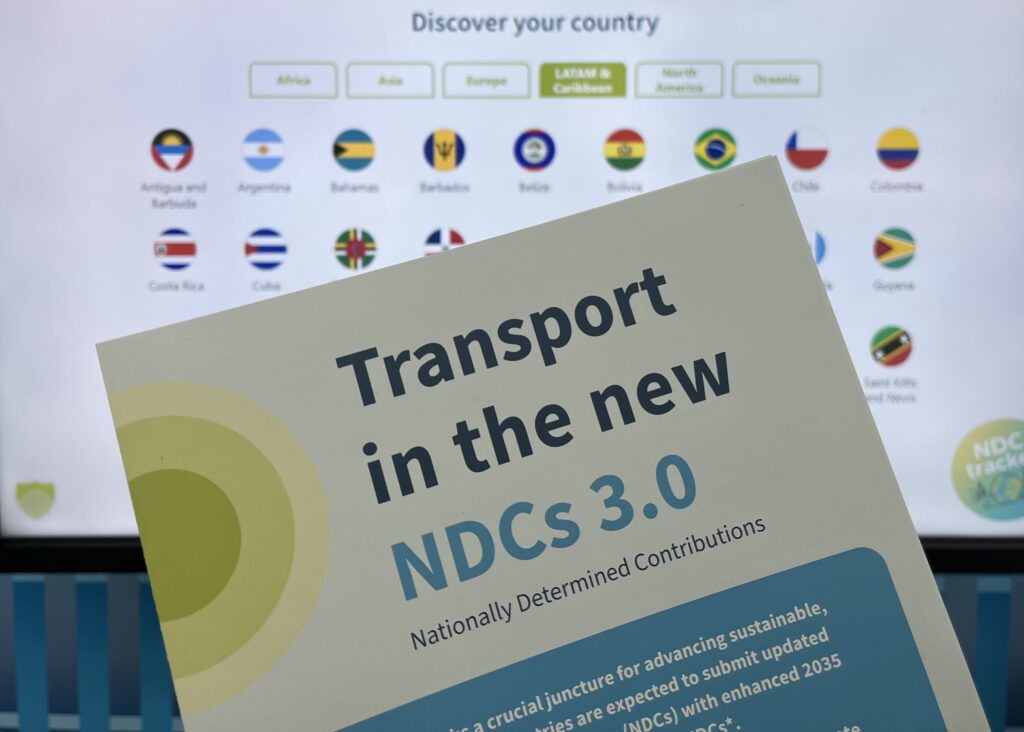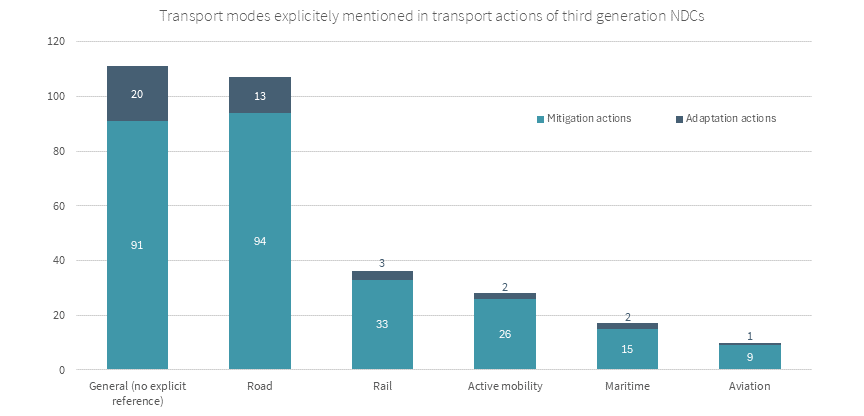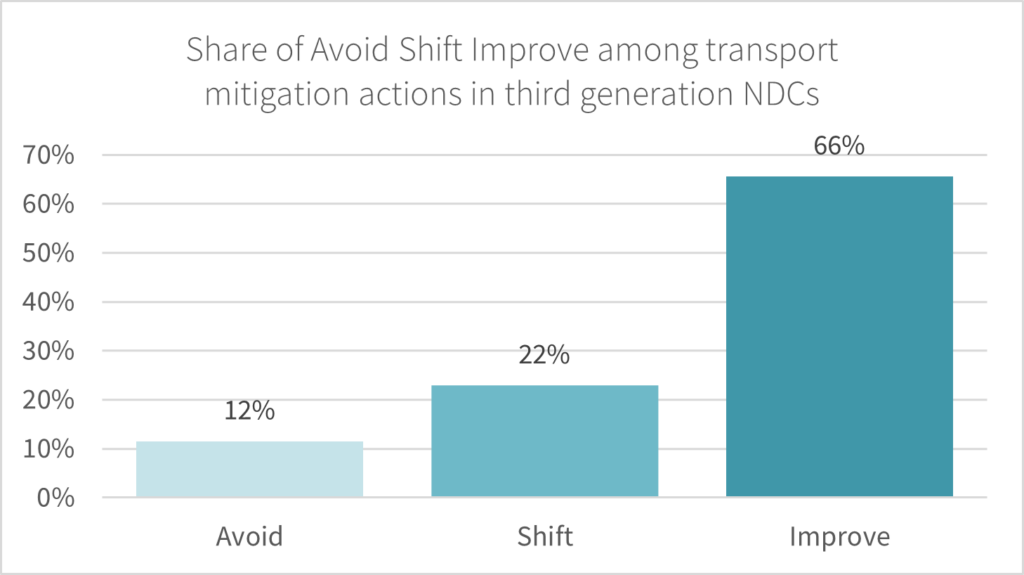
The year 2025 marks a crucial juncture for advancing sustainable, low-carbon transport. Countries are expected to submit updated Nationally Determined Contributions (NDCs) with enhanced 2035 targets, referred to here as third-generation NDCs*. These submissions offer a vital opportunity to accelerate climate action in transport, aligning with national strategies and coordinating efforts across governance levels and sectors. This summary analysis outlines findings from the first 23 third-generation NDCs submitted to the United Nations Framework Convention on Climate Change (UNFCCC), as of 16 May 2025.
|
For information on the background of this project, please refer to this page. We encourage you to use the NDC Transport Tracker for your own work and research. You can easily work with the Excel file which contains all information of this database and analysis sheets. Find relevant instructions in this how-to use guide. Key insights and good practices from the second-generation NDCs can be retrieved here. |
As of May 2025, a total of 23 third-generation NDCs had been submitted. These submissions are evenly distributed per region and account for 35.8% of global transport emissions (excluding international aviation and shipping). While all the submissions are from countries classified as middle- or high-income by the World Bank, Zambia stands out as a Least Developed Country according to UN definitions.
The share of NDCs with transport-specific targets continues to grow: from under 25% in the first generation to 46% in the second, and to 52% in third-generation submissions. Seven of the latest NDCs include dedicated greenhouse gas (GHG) mitigation targets for transport, with Switzerland offering a strong example by setting phased goals toward full decarbonisation by 2050.
In total, 23 non-GHG transport targets by eight NDCs were also identified, nearly half of which (44%) focus on zero-emission vehicles. However, many of these ambitions show lack of alignment with energy targets, particularly with regard to renewable electricity, reducing their transformative potential.
This trend indicates that an increasing number of governments are recognising transport as a key climate sector. Strong transport targets create accountability, encourage investment, and help align national climate strategies with net-zero goals.
"50% reduction in domestic transport emissions by 2030".
"429 Gg CO₂-eq by 2030 (of which 146.78 Gg are conditional)".
"40% below 2010 domestic shipping emissions by 2030 and complete decarbonisation by 2050".
"To reduce unconditionally GHG emissions from the transport sector in 2030 by 52 percent compared to the 1990 level".
"22% below 2010 levels by 2035 in transport and energy emissions".
"41% below 1990 levels by 2035, 57% through 2040 and 100% by 2050".
"20% below 2019 levels by 2035, reaching 24.2 million t CO₂-e".
Third generation NDCs feature a broader portfolio of mitigation actions. On average, the new NDCs include 8.3 transport-related measures, compared to 5.8 in the previous generation. Nearly 60% of these actions fall into two areas: first, electrifying vehicles along with the infrastructure and incentives that support them, and second, shifting trips toward public transport, cycling, walking or rail while reducing unnecessary travel.
On the downside is that aviation and maritime transport continue to receive much less attention, accounting for only 4.2 % of measures. This gap exists partly because emissions from international flights and voyages do not appear in national GHG inventories, reducing pressure to act, and partly because decarbonising these sectors is technically and politically tougher. Still, including them is relevant for a comprehensive transport strategy.
The Marshall Islands shows how to start closing the gap by setting an ambitious domestic shipping target and promotes innovative technologies like wind-assisted propulsion.

Only half of the third-generation NDC include some form of adaptation action. Where action is described, it is mostly about infrastructure resilience such as raising road embankments, reinforcing bridges, and flood-resistant construction materials. Measures related to transport adaptation addressing behaviour, land-use planning, finance or institutional capacity are comparatively scarce. Lesotho’s submission stands out for its detailed adaptation actions, including climate-proofing roads and improving flood control infrastructure.
Road transport, which generates roughly three-quarters of global transport CO₂ emissions, is also the mode most often cited in third-generation NDCs. However, most of both adaptation and mitigation actions did not explicitly reference any specific mode of transport. Adaptation actions referred to specific transport modes far less often than mitigation actions, indicating a less targeted approach in adapting transport infrastructure to a changing climate.

The continued dominance of “Improve” strategies within the Avoid-Shift-Improve (ASI) framework suggests missed opportunities for transformative change. “Improve” actions make up 65.6 percent of transport mitigation measures. In contrast, only 11.5 percent of measures target the “Avoid” pillar.
Applying Avoid-Shift-Improve framework through integrated, inter-modal and balanced approaches is critical to unleashing the full benefits of sustainable, low carbon transport. Singapore’s approach to active mobility and public transport investments is a strong example of a more balanced strategy.

Freight transport remains a major gap. Despite its growing emissions footprint, it continues to be only marginally present in mitigation strategies. Only a third of third-generation NDCs included mitigation actions covering freight or a combination of freight and passenger transport.
If you have any questions or would like to share how you used the data, please contact Nikola Medimorec at nikola.medimorec@slocatpartnership.org or María Belén Vásquez at maria.vasquez1@giz.de.
* We consider all NDC submissions made since November 2024 to be part of the third generation of NDCs, regardless of the document’s title or version number. Therefore, the findings may differ from those of other NDC 3.0 trackers.
Third-generation NDCs (publications since 2024):
Second-generation NDCs (publications from 2022/23):
First-generation NDCs (publications from 2016-18):
The NDC Transport Tracker is developed by GIZ Transport and the SLOCAT Partnership on Sustainable, Low Carbon Transport. It is part of the Mobilize Net-Zero project that is implemented by the Deutsche Gesellschaft für Internationale Zusammenarbeit (GIZ) and financed by the International Climate Initiative (IKI) of the German Federal Ministry for Economic Affairs and Climate Action (BMWK).
 © Maria Belén Vasquez
© Maria Belén Vasquez

Maria Belén Vasquez
maria.vasquez1@giz.de
Visit profile

Nikola Medimorec
nikola.medimorec@slocatpartnership.org